#norse fairy tale
Explore tagged Tumblr posts
Text
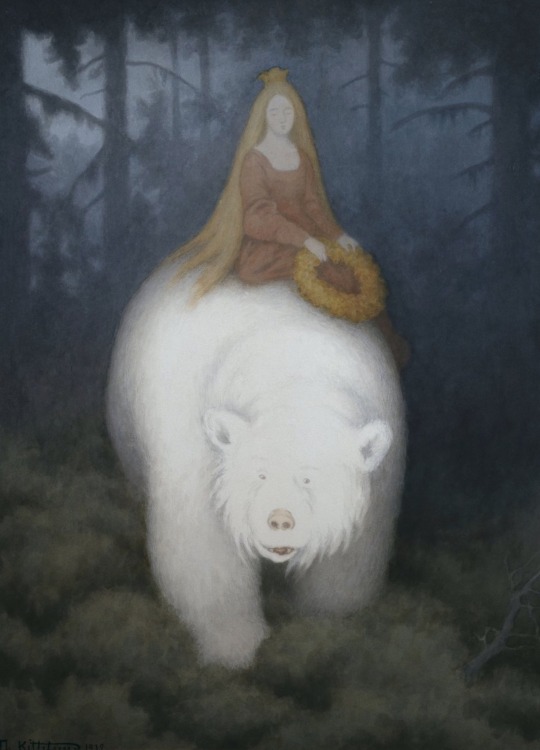
White-Bear-King-Valemon
1912
Artist : Theodor Kittelsen (1857-1914)
#theodor kittelsen#norway#folklore#legend#légende#mythology#fairy tale#norse mythology#saga#1912#king bear#white bear
284 notes
·
View notes
Text
I'm musing on how most riddles in folktales really do not behave like what we consider riddles today. Because they usually fall into one of these categories:
● A cryptic question referring to something that actually happened and only the asker could know the answer to. Like in the Grimms' "The Riddle", where a prince asks a princess this: "What killed none, and yet killed twelve." The answer is a particular raven, which ingested poisoned meat and was then cooked into soup, eaten by twelve robbers who immediately died from it. (This is also called a "neck riddle" because it often shows up in stories where winning the riddle contest saves the protagonist's neck.)
● A cryptic question that has a metaphorical answer, but which could technically have many correct answers, not just one. Like the riddles posed in the ballad "Riddles Wisely Expounded", one of which is "What is louder than the horn?" with the answer "Thunder is louder than the horn."
● An apparently "impossible task" instead of a question. Like in Joseph Jacobs' "The Clever Lass" in which the king orders a clever farmer's daughter to "come to him clothed, yet unclothed, neither walking, nor driving, nor riding, neither in shadow nor in sun." So she undresses and wraps herself in her long hair, attaches a net to the tail of a hose and lets herself be dragged to the castle while holding a sieve over her head to shield her from the sun. (This type of contradiction riddle even shows up in the Mabinogi.)
Of course it matters what role the riddles play in the tale. Usually it's not about the riddle at all, it's just about the protagonist proving how clever and/or witty they are. And in case of the neck riddles, the audience usually also knows the answer, because they know what happened to the protagonist earlier in the story, so the audience gets the pleasure of being smarter than the antagonist.
In the originally Persian tale "Turandot" cryptic questions with (I would say) multiple answers are mixed with something that feels more like a riddle with one "proper answer". For example: "What mother resides on earth, who swallows all her children." The answer is: "The sea, she swallows every stream and river that has ever sprung from her." But I feel like whenever I encounter a "classic" riddle with one proper answer, that usually rhymes, it's either from Greek Mythology (boy did they love a riddling verse), or it a modern riddle added in the retelling...
#riddles#riddle#riddle contest#laura babbles#folklore#fairy tales#norse mythology has rhyming riddles too#but I don't remember any scandinavian folktales with that kind of riddle either... maybe my memory is failing me
144 notes
·
View notes
Text
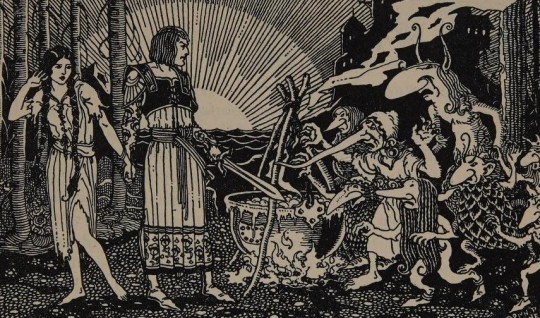
Illustration from East O' the Sun and West O' the Moon for Thourgh Fairy Halls of My Bookhouse by Donn P. Crane (1925)
#donn p. crane#art#illustration#golden age of illustration#1920s#1920s art#vintage art#vintage illustration#vintage#american art#american artist#american illustrators#books#book illustration#fairy tale#fairy tales#fairytale art#norse folklore#classic art
595 notes
·
View notes
Text

Don't trust fairies.
#fairies#fairycore#fairy aesthetic#fairy tail#fairy tales#painting#acryliquepainting#acrylpainting#acrylic#hand drawings#drawing#hand drawn#my artwork#traditional art#artwork#art#my art#myths and legends#myths#dark aesthetic#dark art#evil#sleep paralysis#demon girl#shadow people#shadow person#fantasy#mythical creatures#greek mythology#norse mythology
22 notes
·
View notes
Text
The Surprising Similarities of Little Red and Odin
So this was originally going to be another ‘how Ruby could be an Odin allusion’ post, but in the process of brainstorming, I ended up landing on what feels like a more fun broader topic:
Namely the very interesting similarities in the stories of Little Red Riding Hood and Odin, and the fun potential overlap these two folkloric figures could have when writing fantasy stories.
First off, there are a lot of surprising similarities between the two.
Little Red Riding Hood is a girl known for wearing a hooded cloak (a ‘riding hood’) who wanders through the woods to visit her grandmother, and is menaced and potentially eaten by a monstrous wolf.
And funny enough, basically all of these traits can be found in Odin in one way or another:
For one, Odin has a well-known penchant for wandering Midgard in disguise, as a mysterious hooded figure. Indeed, a hooded cloak is one of Odin’s most well-known visual traits. And just like Little Red, Odin is ALSO menaced by a monstrous wolf in the form of Fenrir, who likewise devours Odin during Ragnarok.
Even Red Riding Hood being a girl has some surprising overlap.
See, we often think of Odin as being this wise, old bearded patriarch of the norse gods, but in reality a lot of that image is the result of more modern depictions attaching elements of Zeus and the christian God to Odin, who doesn’t have nearly as much of those elements as many modern depictions would have you believe. For example, Odin is way more of a loner and trickster archetype who’s often off questing for knowledge.
Fun fact actually; basically our only pre-christian written source we have on Norse mythology comes to us courtesy of the Romans and the contact they had with the Scandinavians via trade routes. Specifically one General Tacitus, who wrote an ethnography in about 98 CE of the Germanic peoples Rome was trading with, which includes some descriptions of the gods they worshiped, which is again pretty much our earliest written source on the Norse pantheon.
Now the thing to remember here is that in these accounts, the Norse gods are referred to as various Roman gods. This was a thing the Romans did with basically every other culture they encountered as a means of cultural assimilation; conflating that cultures’ gods with whichever of their own gods the Romans thought were similar enough, basically saying ‘your gods are our gods’. For example, the accounts seems to refer to Tyr as Mars (aka Ares), likely due to both being war gods, and Thor as Hercules, probably due to both being super strong and giant slayers.
What’s interesting is that the account seem to refer to Odin, the leader of the pantheon, not as Jupiter/Zeus, but rather as Mercury, aka HERMES. A tricksy traveler who among other things, shepherds the dead to the afterlife. I mean if that doesn’t tell you that comparing Odin to Zeus is pretty far off the mark, I don’t know what does.
So with that tangent out of the way, most interestingly for the purposes of this discussion, Odin has a surprising number of feminine traits. Odin seeks and takes the council of women (in particular the Nornir, from whom he learns the prophecies of Ragnarok), something noted to set him apart from the other male gods. And he even learns and practices the art of witchcraft, something practiced specifically by women in Norse mythology. There is at least one instance of Odin even being specifically called a witch, or at least a ‘male witch’, again a specifically feminine term. Plus there’s the fact that Odin is often noted as not being as much of burly fighter like most of the Norse gods, and is instead much more of a crafty schemer.
So taken all together, I think we can really start to see the similarities.
In fact, I think it’s not so hard to believe that the original folktale of Little Red Riding Hood could have some folkloric connection to Odin. As in, if we followed the tellings and retellings of Little Red Riding Hood back through the generations far enough, we might arrive at, among other places, people telling stories of Odin and Fenrir.
BUT, this post is not about making conspiracy theories about folklore, mythology and European oral history.
It’s about pitching fun and interesting ideas about the potential of blending together Odin and Little Red Riding Hood.
Obviously I’ve already talked a fair bit about the fun allusions and parallels Ruby Rose has and could have to Odin; cool and mysterious hooded cloak, use of a spear-like weapon, a character journey with a major emphasis on a pursuit of knowledge and answers, defiant refusal to accept any kind of ‘fate’ of the world (see her contrast with Oz), death symbolism, and of course the possibility of getting a sick eye-patch in the future.
But even outside of RWBY, I think there’s so much fun potential for more general fantasy stories with twists on fairy tales:
I mean everyone’s always re-imagining Little Red as some huntress or ranger with an affinity for or some other connection to wolves.
But just picture a take on Little Red Riding Hood who, in addition to the red hood, penchant for wandering the woods and a complicated relationship with canines, also happens to be a nerdy, goth trans girl who practices witchcraft and has a sick eyepatch and a pair of pet ravens and uses a walking stick that turns into a badass magic spear and she’s also a crafty schemer and a bit of troll and also might sometimes be plotting a war crime or two.
I mean if you ask me that sounds pretty sick. :D
And finally, if you happen to the kind of LOTR fan who remembers that Odin was one of the main inspirations for Gandalf, then yes this means there IS in fact at least a bit of mythological precedent for Big Naturals Gandalf XD
#rambling#rambling about fairy-tales folklore and mythology#little red riding hood#norse mythology#odin#the parallels between little red riding hood and odin#rwby#Ruby Rose#we need a little red riding hood whose also basically odin XD#oral history and mythology are weird and fun#check back in a couple months when i do a post on my urban fantasy idea for a santa claus who turns out to be odin XD
41 notes
·
View notes
Text
Chapter 6 is now up! Crowley does some backbreaking labor and the boys have a chat. Those are not euphemisms.
Til We Have Eyes Chapter 6 (19174 words) by OperaSnail Chapters: 6/11 Fandom: Good Omens (TV) Rating: Explicit Warnings: No Archive Warnings Apply Relationships: Aziraphale/Crowley (Good Omens) Characters: Aziraphale (Good Omens), Crowley (Good Omens), Muriel (Good Omens), Gabriel (Good Omens) Additional Tags: Human Crowley (Good Omens), Angel Aziraphale (Good Omens), Fantasy, Retold Myth, Historical Inaccuracies, Mythological Inaccuracies, Norse Mythology - Freeform, cupid and psyche, Smut, thin plot held together by fucking, Heaven is Terrible (Good Omens), Human Sacrifice, Buried Alive, Hurt/Comfort, Emotional Hurt/Comfort, Gabriel is Not Nice (Good Omens), Disappointing Your Boss Summary:
Crowley is terrified when his community decides that the best use for him is as a sacrifice to secure a favor from the gods. But it seems that fate has something else in store for him.
#good omens#fanfic#good omens fanfiction#my fic#aziraphale#crowley#aziracrow#retold myth#retold fairy tale#ineffable husbands#mythology#norse mythology
21 notes
·
View notes
Text
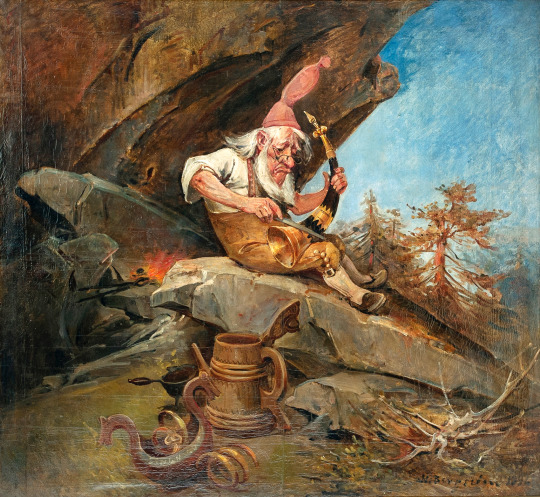
Hornsmeden by Nils Bergslien
#nils bergslien#art#hornsmeden#norway#norwegian#smith#horn#horns#scandinavia#scandinavian#nisse#folklore#fairy tales#landscape#europe#european#nordic#northern europe#norse#romantic#legends#mountains#mountain#forge#mythological creature#mythology#mythological#christmas
68 notes
·
View notes
Text
I made something

#Mythology#ancient greek mythology#greek mythology#Egyptian mythology#Norse mythology#Fairy tales#Folk tales#classic literature#I want to know how much the Netflix adaptations fail to original#Similarly with how much Greek Norse and other mythology retellings fail
15 notes
·
View notes
Text
I'm now reading another of Heidi Anne Heiner's fairy tale collections. Sleeping Beauties: Sleeping Beauty and Snow White Tales from Around the World. Since I enjoyed Cinderella Tales from Around the World so much, I couldn't resist opening another of Heiner's books.
The first part of the book is devoted to the different international versions of Sleeping Beauty, the second part to the different versions of Snow White. This is followed by other tales of "sleeping beauties" that don't fit nearly into either category.
We start with the medieval Sleeping Beauty prototype tales from the 13th and 14th centuries.
*The earliest known prototype of the Sleeping Beauty story is the Norse and Germanic legend of Brynhild (a.k.a. Brunhild, Brunhilda, Brünnhilde, or other variations). This legend first appears in the Poetic Edda, the Prose Edda, and the Volsunga Saga from 13th century Iceland. It also appears in the German Nibelungenlied (although that version doesn't include the enchanted sleep), and its most famous modern adaptation is in Richard Wagner's four-opera cycle Der Ring des Nibelungen. The figure of Brynhild also inspired the Marvel superheroine Valkyrie.
**The Sleeping Beauty-like portion of the legend is this. The beautiful and strong-willed Brynhild is one of the valkyries, the warrior maiden servants (and in some versions daughters) of Odin (or Woden, Wotan, etc.) who preside over battlefields and bring the souls of fallen heroes to Valhalla. But Brynhild disobeys Odin by saving (or trying to save) the life of a warrior who was marked for death. (The man's identity, why he was meant to die, why she defends him, and whether she succeeds in saving him or not varies between versions.) As punishment, Odin banishes her to the mortal realm, pricks her with a "sleep thorn," and places her in a castle (or just on a rock) surrounded by a ring of fire, condemning her to sleep until a man brave enough to venture through the flames arrives to wake her and become her husband. (In some versions, she has attendants and servants who all sleep along with her.) Many years later, the fearless hero Sigurd, or Siegfried, succeeds in passing unharmed through the flames and wakes Brynhild by cutting off her valkyrie armor (or in later retellings influenced by Sleeping Beauty, with a kiss). The couple doesn't live happily ever after, however: their further adventures and eventual tragic fates are a story for another day.
**Even though it's a well-known fact that in "the original Sleeping Beauty stories," the prince (or his counterpart) impregnates the sleeping heroine and she wakes after she gives birth, no such thing happens in this earliest proto-version. If we assume that this really is the Western world's first tale of a heroine in an enchanted sleep, then it seems as if that sordid detail was a later addition.
*Next in Heiner's book come several medieval French Sleeping Beauty tales, mostly from Arthurian romances. These are the tales where we first see the motif of the heroine's love interest raping her in her sleep and fathering a child. Since few of them have ever been translated into modern English, the book simply summarizes them instead of printing them in full.
**The best-known of these stories, which most resembles Sleeping Beauty as we know it today, is the tale of Troylus and Zellandine from Le Roman de Perceforest, an Arthurian romance from 14th or 15th century France. In this tale, a knight named Troylus loves a princess named Zellandine. Then he learns that while spinning, Zellandine has suddenly fallen into a deep sleep, from which no one can wake her. With the help of a spirit named Zephir and the goddess Venus, Troylus enters the tower where she lies and, at Venus's urging, he takes her virginity. Nine months later, Zellandine gives birth to a son, and when the baby sucks on her finger, she wakes. Zellandine's aunt now arrives, and reveals the whole backstory, which only she knew. When Zellandine was born, the goddesses Lucina, Themis, and Venus came to bless her. As was customary, a meal was set out for the three goddesses, but then the room was left empty so they could enter, dine, and give their blessings unseen; but the aunt hid behind the door and overheard them. Themis received a second-rate dinner knife compared to those of the other two, so she cursed the princess to someday catch a splinter of flax in her finger while spinning, fall into a deep sleep, and never awaken. But Venus altered the curse so that it could be broken and promised to ensure that it would be. When the baby sucked Zellandine's finger, he sucked out the splinter of flax. Eventually, Zellandine and Troylus reunite, marry, and become ancestors of Sir Lancelot.
***This tale provides some answers for questions that the traditional Sleeping Beauty raises. In the familiar tale, the king, the queen, and their court know about the curse, so why do they keep it a secret from the princess? Yes, they avoid upsetting her by doing so, but the end result is that when she finally sees a spindle, she doesn't know to beware of it. Why not warn her? And why is there a random old woman in the castle, spinning with presumably the kingdom's one spindle that wasn't destroyed, and why, despite living in the castle does she not know about the curse? (It's no wonder that most adaptations make her the fairy who cursed the princess in disguise.) Yet in this earlier version, there are no such questions: no one except the eavesdropping aunt knows about the curse, because it was cast in private, so no one can take precautions against it. Another standout details is the fact that Zellandine's sleep doesn't last for many years, and that the man who wakes her already loved her before she fell asleep. Disney didn't create those twists after all!
**The other medieval French Sleeping Beauty tales are Pandragus and Libanor (where Princess Libanor's enchanted sleep only lasts one night, just long enough for Pandragus to impregnate her), Brother of Joy and Sister of Pleasure (where the princess isn't asleep, but dead – yet somehow the prince still impregnates her – and is revived by an herb that a bird carries to her), and Blandin de Cornoalha (a knight who, refreshingly, doesn't impregnate the sleeping maiden Brianda, but breaks her spell by bringing a white hawk to her side).
*All of these early Sleeping Beauty tales are just one part of bigger poetic sagas. Maybe this explains why Sleeping Beauty is fairly light on plot compared to other famous fairy tales (i.e. we're told what's going to happen, and then it does happen, and it all seems inevitable from the start). Of course one argument is that it's a symbolic tale: symbolic of a young girl's coming-of-age, as the princess's childhood ends when she falls asleep and her adulthood begins when she wakes, and/or symbolic of the seasons, with the princess as a Persephone-like figure whose sleep represents winter and whose awakening represents spring. That's all valid. But maybe another reason for the flimsy plot is that the earliest versions of the tale were never meant to stand alone. They were just episodes in much longer and more complex narratives.
@ariel-seagull-wings, @adarkrainbow, @themousefromfantasyland
#sleeping beauty#fairy tale#variations#sleeping beauties: sleeping beauty and snow white tales from around the world#heidi anne heiner#norway#iceland#germany#norse mythology#france#england#italy#tw: rape#tw: cannibalism
48 notes
·
View notes
Text

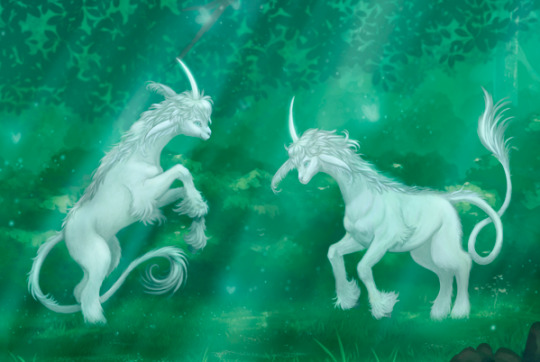

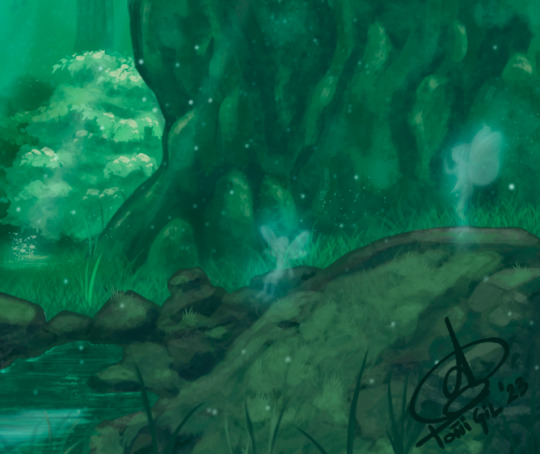
For our Vaesen campaign. Meet Vili and Ve, the more recent inhabitants of the swedish fjords, twin baby unicorns, a true miracle. I don't usually ✨paint✨but it felt fitting for the illustration. I hope you like it despite the many things it lacks :)
#my art#digital art#illustration#fantasy#vaesen#ttrpg#art#fae#fairy tale#unicorn#forest#fairy#oak tree#vaesen rpg#rpg#fantasy illustration#fantasy art#medieval fantasy#mythology#norse mythology#folklore#mythological creature#painting#landscape#trees#crook
77 notes
·
View notes
Text
if i can get even one person to listen to The Mechanisms i would have fulfilled my purpose
#Do you want a tragic adaptation of greek mythology featuring genderless Ulysses (Odysses) as a weary soldier completely grief stricken by#The war crimes they committed? Ulysses dies at dawn got you complete with anticapitalist messages all sung in a cyperpunk blues world#Do you want grim dark tragic fairy tale adaptation with lesbian Cinderella desperately looking for her war criminal wife#Who was kidnapped by an evil space emperor to create army of clone soldiers and is opposed by said wife's sister who is Snow White?#Once Upon A Time (in Space) got you covered#Do you want Arthurian legend figures in Wild West in Space setting where Arthur Guinevere and Lancelot are healthy poly couple and#Mordred is a sympathetic trans man with a 'Love was there but it couldnt save anyone' style story? High Noon Over Camelot#Do you want Norse Mythology in a style of Train Murder mystery with a horrifying twist#Lesbian morally grey Loki and her morally grey wife Sigyn? The Bifrost Incident#They are all in space and are tragedies and fuck severely#the mechanisms#once upon a time (in space)#ulysses dies at dawn#high noon over camelot#the bifrost incident#Listen in that order#for reasons#I havent even talked about Frankenstein or Alice or Hereward the Wake or Redeath#empty thoughts#edit: Yes i am pinning this post what about it?
125 notes
·
View notes
Text


My piece for @poisonapplezine Fafnir destroying and poisoning the lands 🐉
#zine#zine art#artist on tumblr#illustration#fafnir#fairy tale#myths#norse mythology#yeay some new...#old art i can post now xD#this was so fun to work on <3
111 notes
·
View notes
Text

ANNOUNCEMENT: ✨I’m so happy to announce that my short story inspired by the Norse Myths has been accepted for publication in The Mythic Circle by The Mythopoeic Society! 🤩
This tale about Loki and Sigyn that I wrote is really special to my heart and I can’t wait to share it with the world! ☺️♥️
Here’s a moodboard that I made to capture the story’s aesthetic and aura and here’s a short blurb:
the story’s blurb: Sigyn, the wife of Loki & goddess of mercy & loyalty, considers whether she is being admirably loyal or foolish for staying by her husband’s side. If she stays, she loses the future of her eternal life. If she leaves Loki, she risks losing him forever.💔✨
I’ll keep everyone posted about this publication and when & where you can get your copy! 📚
Thank you all for your support! 🥰 My (published) author adventures are just beginning! 🌟
~Danielle🪽
#Loki#short story#norse gods#norse mythology#norse myths#loki x sigyn#sigyn#loki and sigyn#reimagining#retelling#author#publication#literary magazine#fairy tales#writers on tumblr#writing#mythology and folklore#loki ragnarok#loyalty#lovers#tragedy#myth retelling#stories#god of mischief#trickster
26 notes
·
View notes
Text
Digital Detox 📲, going low-tech and living off-grid are gnome-related activities 🪴✨

https://spiritsurfers.substack.com/p/video-decoding-the-gold-ray-through
#spirituality#fantasycore#spiritual awakening#spiritualgrowth#fairy tale#fae#fairycore#faerie#fairies#fairy aesthetic#gnome#gnome post#gnomecore#gnomeo and juliet#deep gnome#elf#dwarf#elementals#elemental#greek mythology#norse mythology#mythology rp#mythology and folklore#folklore#middle earth#lord of the rings#tolkien#digital detox#grass#touch grass
11 notes
·
View notes
Text
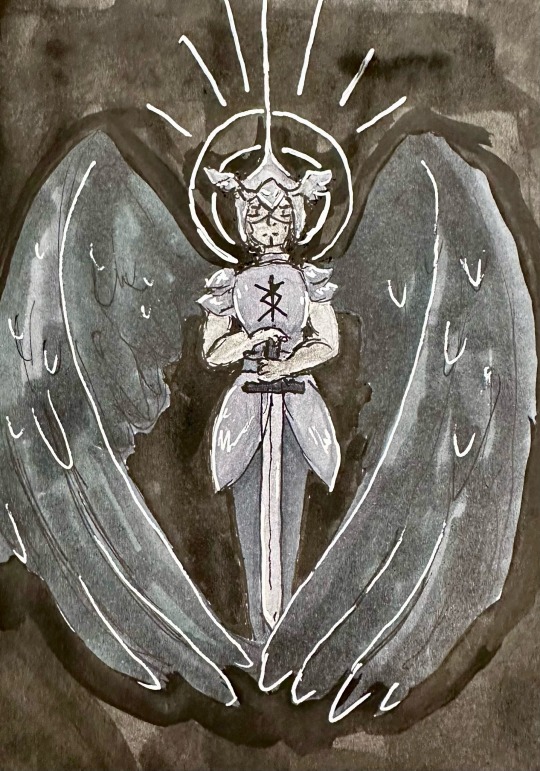
Day 31: Death Angel
Thank you so much to everyone who supported me and helped me finish my first Inktober!
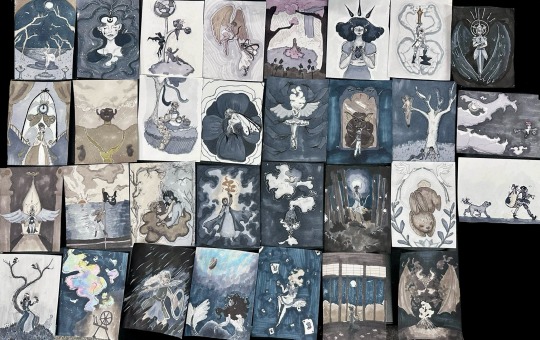
#art#inktober#markers#fairy tales#greek mythology#norse mythology#phillipine mythology#mesopotamian mythology#chinese mythology#japanese mythology#Valkyrie
10 notes
·
View notes
Text
Chapter 7 is up! The boys have a picnic, and then everything goes to shit.
Til We Have Eyes Chapter 7 (23328 words) by OperaSnail Chapters: 7/11 Fandom: Good Omens (TV) Rating: Explicit Warnings: No Archive Warnings Apply Relationships: Aziraphale/Crowley (Good Omens) Characters: Aziraphale (Good Omens), Crowley (Good Omens), Muriel (Good Omens), Gabriel (Good Omens) Additional Tags: Human Crowley (Good Omens), Angel Aziraphale (Good Omens), Fantasy, Retold Myth, Historical Inaccuracies, Mythological Inaccuracies, Norse Mythology - Freeform, cupid and psyche, Smut, thin plot held together by fucking, Heaven is Terrible (Good Omens), Human Sacrifice, Buried Alive, Hurt/Comfort, Emotional Hurt/Comfort, Gabriel is Not Nice (Good Omens), Disappointing Your Boss Summary:
Crowley is terrified when his community decides that the best use for him is as a sacrifice to secure a favor from the gods. But it seems that fate has something else in store for him.
#good omens#fanfic#good omens fanfic#my fic#crowley#aziraphale#aziracrow#ineffable husbands#retold myth#retold fairy tale#norse mythology
8 notes
·
View notes